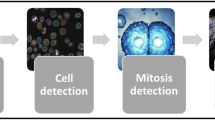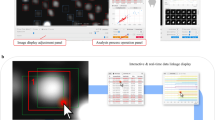Abstract
The aim of automated stem cell motility analysis is reliable processing and evaluation of cell behaviors such as translocation, mitosis, death, and so on. Cell tracking plays an important role in this research. In practice, tracking stem cells is difficult because they have frequent motion, deformation activities, and small resolution sizes in microscopy images. Previous tracking approaches designed to address this problem have been unable to generalize the rapid morphological deformation of cells in a complex living environment, especially for real-time tracking tasks. Herein, a deep learning framework with convolutional structure and multi-output layers is proposed for overcoming stem cell tracking problems. A convolutional structure is used to learn robust cell features through deep features learned on massive visual data by a transfer learning strategy. With multi-output layers, this framework tracks the cell’s motion and simultaneously detects its mitosis as an assistant task. This improves the generalization ability of the model and facilitates practical applications for stem cell research. The proposed framework, tracking and detection neural networks, also contains a particle filter-based motion model, a specialized cell sampling strategy, and corresponding model update strategy. Its current application to a microscopy image dataset of human stem cells demonstrates increased tracking performance and robustness compared with other frequently used methods. Moreover, mitosis detection performance was verified against manually labeled mitotic events of the tracked cell. Experimental results demonstrate good performance of the proposed framework for addressing problems associated with stem cell tracking.













Similar content being viewed by others
References
Weissman I (2005) Stem cell research. J Am Med Assoc 294(11):1359–1366
Dimarakis I, Levicar N (2007) Cell culture medium composition and translational adult bone marrow-derived stem cell research. Stem Cells 24(12):2888–2890
Kircher MF, Gambhir SS, Grimm J (2011) Noninvasive cell-tracking methods. Nat Rev Clin Oncol 8(11):677–688
Sacan A, Ferhatosmanoglu H (2008) Celltrack: an open-source software for cell tracking and motility analysis. Bioinformatics 24(14):1647–1649
Bise R, Yin Z, Kanade T (2011) Reliable cell tracking by global data association. In: Proceedings of 2011 IEEE international symposium on biomedical imaging: from nano to macro, vol 48, pp 1004–1010
Meijering E, Dzyubachyk O, Smal I (2012) Methods for cell and particle tracking. Methods Enzymol 504:183–200
Alkofahi O, Radke RJ, Goderie SK, Shen Q, Temple S, Roysam B (2006) Automated cell lineage construction: a rapid method to analyze clonal development established with murine neural progenitor cells. Cell Cycle 5(3):327–335
Li F, Zhou X, Ma J, Wong STC (2010) Multiple nuclei tracking using integer programming for quantitative cancer cell cycle analysis. IEEE Trans Med Imaging 29(1):96–105
Padfield D, Rittscher J, Roysam B (2011) Coupled minimum-cost flow cell tracking for high-throughput quantitative analysis. Med Image Anal 15(4):650–668
Ren Y, Xu B, Zhang J, Zhang W (2015) A generalized data association approach for cell tracking in high-density population, In: Proceedings of IEEE international conference on control, automation and information sciences (ICCAIS), pp 502–507
Mukherjee DP, Ray N, Acton ST (2004) Level set analysis for leukocyte detection and tracking. IEEE Trans Image Process 13(4):562–572
Lou X, Hamprecht FA (2011) Structured learning for cell tracking. In: Advances in neural information processing systems, pp 1296–1304
Li K, Chen M, Kanade T (2008) Cell population tracking and lineage construction with spatiotemporal context. Med Image Anal 12(5):546–566
Maska M, Ulman V, Svoboda D, Matula P, Matula P, Ederra C, Urbiola A (2014) A benchmark for comparison of cell tracking algorithms. Bioinformatics 30(11):1609–1617
Jiang RM, Crookes D, Luo N, Davidson MW (2010) Live-cell tracking using sift features in DIC microscopic videos. IEEE Trans Bio-med Eng 57(9):2219
Guo D, Al VDV (2014) Red blood cell tracking using optical flow methods. IEEE J Biomed Health Inform 18(3):991–998
Wu Y, Lim J, Yang MH (2013) Online object tracking: A benchmark. In: Proceedings of IEEE conference on computer vision and pattern recognition, pp 2411–2418
Li X, Hu W, Shen C, Zhang Z, Dick A, Hengel AVD (2013) A survey of appearance models in visual object tracking. ACM Trans Intell Syst Technol 4(4):1–48
Lecun Y, Bengio Y, Hinton G (2015) Deep learning. Nature 521(7553):436–444
Zhang H, Cao X, Ho JKL, Chow TWS (2016) Object-level video advertising: an optimization framework. IEEE Trans Ind Inform 99:1
Oyedotun OK, Khashman A (2017) Deep learning in vision-based static hand gesture recognition. Neural Comput Appl 28:3941–3951
Krizhevsky A, Sutskever I, Hinton GE (2012) Imagenet classification with deep convolutional neural networks. In: Advances in neural information processing systems, vol 25, no 2
Wei J, Li XP, Sessler AM (2011) Mitosis detection for stem cell tracking in phase-contrast microscopy images 48(1):2121–2127
Simonyan K, Zisserman A (2014) Very deep convolutional networks for large-scale image recognition. In: Proceedings of IEEE conference on computer vision and pattern recognition
Chang C, Ansari R (2005) Kernel particle filter for visual tracking. IEEE Trans Signal Process Lett 12(3):242–245
Wang N, Yeung DY (2013) Learning a deep compact image representation for visual tracking. In: Advances in neural information processing systems, pp 809–817
Bengio Y (2009) Learning deep architectures for AI, Foundations and trends®. Mach Learn 2(1):1–127
Hinton GE, Salakhutdinov RR (2006) Reducing the dimensionality of data with neural networks. Science 313(5786):504–507
Abouelnaga Y, Ali OS, Rady H, Moustafa M (2016) Cifar-10: Knn-based ensemble of classifiers. In: Proceedings of international conference on computational science and computational intelligence
Carvalho EF, Engel PM (2014) Convolutional sparse feature descriptor for object recognition in cifar-10. In: Intelligent systems, pp 131–135
Wu Y, Lim J, Yang MH (2015) Object tracking benchmark. IEEE Trans Pattern Anal Mach Intell 37:1834–1848
Babenko B, Yang MH, Belongie S (2011) Robust object tracking with online multiple instance learning. IEEE Trans Pattern Anal Mach Intell 33(8):1619
Ahuja N (2012) Robust visual tracking via multi-task sparse learning. In: Proceedings of IEEE conference on computer vision and pattern recognition, pp 2042–2049
Kwon J, Lee KM (2010) Visual tracking decomposition. In: Proceedings of IEEE conference on computer vision and pattern recognition, pp 1269–1276
Acknowledgements
This work was supported by the Key Program of National Natural Science Foundation of China (61402306, 61432012, U1435213).
Author information
Authors and Affiliations
Corresponding author
Ethics declarations
Conflict of interest
We declare that we have no financial and personal relationships with other people or organizations that can inappropriately influence our work, there is no professional or other personal interest of any nature or kind in any product, service, and company that could be construed as influencing the position presented in or the review of this manuscript.
Rights and permissions
About this article
Cite this article
Wang, Y., Mao, H. & Yi, Z. Stem cell motion-tracking by using deep neural networks with multi-output. Neural Comput & Applic 31, 3455–3467 (2019). https://doi.org/10.1007/s00521-017-3291-2
Received:
Accepted:
Published:
Issue Date:
DOI: https://doi.org/10.1007/s00521-017-3291-2




